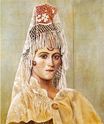©Pablo Picasso - Olga in a Mantilla 1917
 |
 |
 |
 |
 |
 |
 |

Olga in a Mantilla 1917
64x53cm oil/canvas
Museo Picasso Málaga, Private collection
The image is only being used for informational and educational purposes
<< Previous G a l l e r y Next >>
From Museo Picasso Málaga:
Having been invited by Serge de Diaghilev and the Ballets Russes to design the costumes and stage sets for Parade, choreographed by Léonide Massine to a libretto by Jean Cocteau and an original score by Erik Satie, Picasso travelled in February 1917 to Rome, where he met the Russian ballerina Olga Khokhlova. After the Italian tour, which saw the burgeoning of Olga and Picasso’s love affair, the Company travelled to Paris, where Parade premièred on 18 May at the Théâtre du Châtelet, and then continued on to Spain. Picasso joined them in Madrid, and at the beginning of June he settled in Barcelona, where his mother Doña María lived, as well as his sister Lola, married to the doctor Juan Vilató. He also met up again with old friends, Catalan painters and critics, and shared a studio with Rafael Padilla. From 23 to 30 June, the Ballets Russes performed at the Gran Teatro del Liceo in Barcelona: Olga danced around ten roles, among which were the principal roles of a maid of honour in Les Ménines and Felicia in Les Femmes de bonne humeur, both original works by Massine. Although Olga had received much encouragement from both the choreographer and Diaghilev, and had a promising career ahead of her in the troupe, she nevertheless decided not to take part in the tour to South America, preferring to stay with Picasso. The artist had introduced her to his family as his future wife, and to mark their engagement he painted Olga Khokhlova with a Mantilla, the first known oil portrait of the young woman. As a symbolic gesture, he gave it to Doña María.